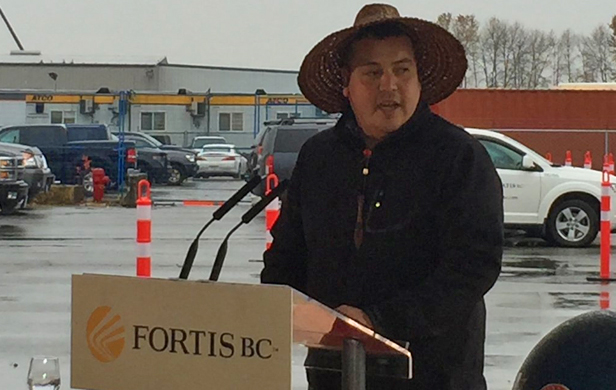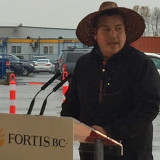
Will LNG proposals put coastal First Nations at odds with those fighting to protect land and water in Treaty 8 Territory?
By Kevin Washbrook
On an unusually chilly afternoon last month I had the opportunity to listen to Chief Liz Logan of the Fort Nelson First Nation and Grand Chief Stewart Phillip of the Union of BC Indian Chiefs at the Drums for the Peace Rally in front of BC Hydro headquarters in downtown Vancouver. The Rally was held to mark the start of Treaty 8 First Nations’ federal appeals court case, which argues that the BC government’s approval of Site C Dam infringes on their treaty rights.
I was struck by the speakers’ determination to continue fighting Site C in court even as BC Hydro races to clear land for this destructive project. It saddens me that Christy Clark would willingly sacrifice the traditional territory of Treaty 8 Nations, not to mention some of the best farmland in BC in pursuit of her government’s obsession with exporting LNG, but that afternoon I was buoyed by the resilience of these front line land defenders. The fight against Site C clearly isn’t over.
Tsawwassen chief downplays LNG plant’s impacts

Like many people, a few days later, I was surprised to hear Chief Bryce Williams of Tsawwassen First Nation announce a joint proposal with FortisBC and others for yet another LNG terminal, this one on Tsawwassen Nation treaty lands at Roberts Bank on the Fraser delta. Chief Williams explained that he was neutral on the proposal and that it would be put to a community vote, but he also took effort describe the project as relatively low impact, including pointing out that the LNG terminal would be powered by electricity, and not natural gas, if it went ahead.
Cooling and condensing natural gas into a compact liquid for export is a very energy intensive process, so powering up this new LNG terminal would take a lot of electricity. As I listened to Chief Williams I had to wonder, is this the LNG project that will make Site C dam inevitable? And if so, how will Chief Williams and the Tsawwassen people justify that to the Treaty 8 Nations in Northeast BC who are fighting to keep it from being built?
Lots more fracking needed to supply LNG plant
When Fortis, the BC government and the many LNG proponents now active in BC describe their LNG proposals as “low impact”, they are talking about the LNG facility itself. However, that LNG doesn’t come from nowhere. If the Tsawwassen LNG proposal goes ahead it will require an enormous amount of natural gas from the fields of Northeast BC — and that demand will trigger more well drilling and more fracking, and contaminate more fresh water in Treaty 8 territory.
Listening to Chief Williams I was reminded of Dene-Cree lawyer Caleb Behn — recently featured in the movie Fractured Land — who, along with many others, is working hard to reduce the impacts from all the seismic exploration, roadbuilding, well drilling and fracking generated by the natural gas boom in their traditional territories in the northeast.
LNG industry’s inconvenient upstream truths
These upstream impacts are an inconvenient truth that LNG proponents don’t like to talk about when they pitch their proposals. Thanks to a model developed by the Pembina Institue and Navius Research, we’re now able to produce a solid estimate of the upstream impacts of any given LNG proposal.
The Pembina model says that over a 30-year period, sourcing natural gas to supply the the Tsawwassen LNG project could require more than 2000 new wells in northeast BC, could use more than 30 billion litres of freshwater, and could produce more than 11 billion litres of waste water. The model also says that over that 30-year period the Tsawwassen project could generate more than 47 million tonnes of climate emissions during the drilling, processing and transport of gas to the LNG facility on the Fraser Delta.
On Wednesday December 16 Tsawwassen First Nations community members will vote on whether to move forward with their LNG proposal. I have no doubt that Fortis and the other project partners are actively promoting the benefits that would follow from approval. I sincerely hope that community members also have access to information on the upstream impacts that would be generated by that approval, so that they can make a fully informed decision on the project.
Kevin Washbrook is a director of Voters Taking Action on Climate Change.


lol, every one of the posts here are so presumptuous and “whining” about something that they have read, and states clearly that it will be voted on. And the vote is in and it was defeated. Idiots.
Greed trumping our environment. Again?
Sixteen members of the Tsawwassen Band are going to determine the outcome of this preposterous project?
Colour me Aghast!
I had hope for Tsawwassen when Mr Williams was voted in. That quickly vanished. This is disgraceful.